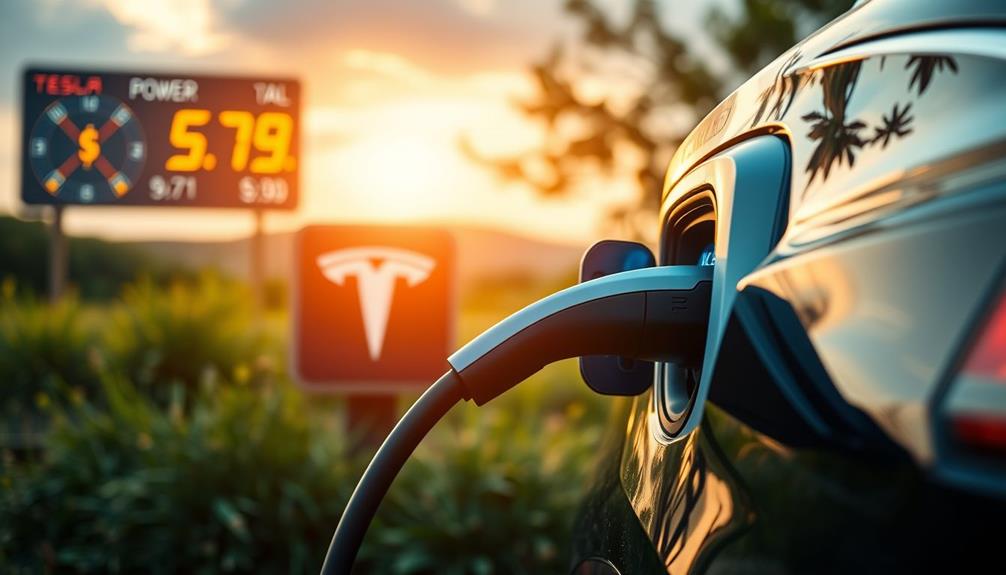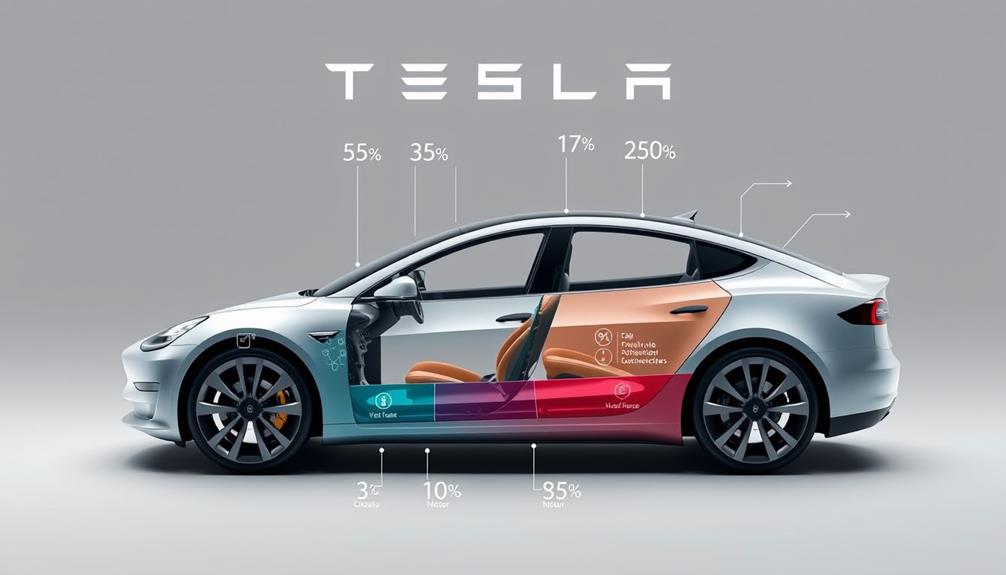Charging a Tesla can take anywhere from 3 kW to as much as 350 kW, depending on the charger type. Level 1 chargers pull about 1.4 kW from a standard outlet, while Level 2 chargers can range from 3 kW to 19 kW, allowing for quicker charging. For rapid needs, DC Fast Chargers deliver impressive power, charging up to 80% in just 20-40 minutes. Your choice of charger affects how quickly you can get back on the road. Stick around to discover more about optimizing your Tesla charging experience!
Key Takeaways
- Tesla vehicles utilize varying charging levels, with Level 1 chargers providing up to 1.4 kW and Level 2 chargers offering up to 19 kW.
- DC Fast Charging stations can deliver power outputs ranging from 50 kW to 350 kW, enabling rapid charging for Tesla models.
- The Model S and Model X, with a 100 kWh battery, require around 111 kWh to fully charge due to efficiency losses.
- Charging efficiency for Tesla vehicles averages around 94%, affecting the actual power needed for charging.
- Level 2 chargers typically provide 28 miles of range per hour, making them efficient for home charging needs.
Overview of EV Charging Levels

When it comes to charging your electric vehicle (EV), understanding the different levels is fundamental. EV charging is categorized into three main levels: Level 1 AC, Level 2 AC, and DC Fast Charging. Each level offers distinct charging speeds and efficiencies, essential for managing your battery capacity and range per hour.
Level 1 AC charging operates on a standard 120V outlet, providing a modest charging speed of 3-6 miles of range per hour. This level is ideal for overnight charging at home.
In contrast, Level 2 AC charging utilizes 208-240V outlets, delivering up to 50 miles of range per hour. With power outputs ranging from 3 kW to 19 kW, Level 2 considerably enhances charging efficiency.
For those in need of rapid charging, DC Fast Charging stations are the solution. These can charge an EV's battery to 80% in just 20-40 minutes, with some stations offering outputs up to 350 kW.
Currently, there are over 15,000 DC Fast Charging stations in the U.S., and their numbers are expected to grow, making them a critical resource for your EV charging needs.
Key Factors Influencing Charging Costs

When you're charging your Tesla, the costs can vary widely based on local electricity rates and your vehicle's specific battery needs.
For instance, a Model S will generally rack up higher charges than a Model 3 due to its larger battery size.
It's crucial to take into account these factors to better manage your charging expenses.
Electricity Rate Variability
Electricity rate variability plays an essential role in determining the cost of charging your Tesla. In the U.S., average electricity rates hover around $0.16 per kWh, but these can vary widely based on geographical location. For example, if you're in San Diego, you might pay $0.424 per kWh, whereas in St. Louis, it's only $0.129 per kWh.
High local utility pricing in states like California and Hawaii can greatly increase your charging costs as a Tesla owner. Additionally, local regulations and fees can further influence what you pay.
Charging costs also fluctuate depending on the time of day, with off-peak rates typically offering lower prices. This means charging overnight could save you a lot.
The depth of discharge (DoD) and state of charge (SoC) also play key roles in your effective charging costs, as they dictate how much energy you need to restore your battery. By understanding these factors, you can make informed decisions on when and where to charge, ultimately reducing your overall costs while enjoying your Tesla.
Model-Specific Charging Needs
Understanding the specific charging needs of your Tesla Model S can help you better manage costs and optimize your charging strategy.
The Model S comes equipped with a 100 kWh battery, which requires about $13.96 to fully charge at an average electricity rate of $0.16 per kWh. However, due to a charging efficiency of around 90%, you'll actually need approximately 111 kWh of electricity to charge from empty.
Charging time is another key factor; using a Level 2 charger with an output of 11.5 kW, you can fully charge your Model S overnight in about 11.5 hours.
If you're on the go, you might consider using Tesla's Supercharger stations. The cost to fully charge at these locations can range from $10.45 to $57.00, depending on location and demand, but the average cost is around $18.29.
Tesla Battery Capacity and Consumption

When you consider Tesla's battery capacity, you'll find models range from 50 kWh in the Model 3 to 100 kWh in the Model S and X.
This capacity directly affects how far you can drive and how quickly you can recharge.
Understanding energy consumption, which averages around 34 kWh per 100 miles, helps you plan your journeys more effectively.
Battery Capacity Overview
Tesla vehicles showcase a range of battery capacities that cater to different driving needs and preferences. The Tesla Model 3 features a 50 kWh battery, while the Model S and Model X can have capacities up to 100 kWh.
This variance considerably impacts the charging duration; for instance, a Standard Range Model 3 with a 75 kWh battery takes about 6.5 hours to fully charge at a rate of 11.5 kW.
Battery capacity also plays a vital role in determining your electric vehicle's driving range. The Model 3 offers an impressive range of around 267 miles, while the Model S can reach up to 405 miles on a full charge.
Energy consumption varies by model too. The Model 3 stands out as the most efficient, using about 15-20 kWh per 100 miles, whereas the Model X is less efficient, consuming approximately 34 kWh per 100 miles.
Understanding your Tesla's battery capacity and energy consumption is essential for optimizing your driving experience and planning your charging needs effectively. By being aware of how energy is used during different driving conditions, you can better predict how long your battery will last on a single charge. Additionally, regularly checking your vehicle’s health through over-the-air updates and adhering to Tesla maintenance requirements ensures that your car remains efficient and performs at its best. Proper maintenance not only extends battery life but also optimizes overall vehicle longevity.
With the right information, you can make the most of your Tesla's capabilities.
Energy Consumption Analysis
While evaluating energy consumption in Tesla vehicles, it's crucial to take into account how battery capacity directly influences efficiency and range. Tesla offers a range of battery sizes, from the 50 kWh Model 3 to the 100 kWh Model S and X. The Model 3 stands out as the most energy-efficient, consuming about 15-20 kWh per 100 miles, while the larger Model X typically uses more energy due to its increased weight.
Here are a few key points about energy consumption:
- The average Tesla consumes around 34 kWh per 100 miles, costing about $0.05 per mile.
- Charging efficiency sits at roughly 94%, meaning not all electricity drawn from the grid is effectively used.
- Weather conditions can impact battery efficiency, potentially increasing energy consumption by up to 40%.
Understanding these factors enables you to make informed decisions regarding charging and range planning.
By optimizing your usage based on battery size and conditions, you can maximize your driving experience while minimizing energy costs.
Whether you're driving a Model 3 or Model X, knowing your energy consumption can enhance your electric vehicle journey.
Charging Time and Efficiency

Charging time and efficiency are essential factors for Tesla owners, impacting how quickly you can get back on the road. The charging time for your Tesla vehicle is calculated by dividing the battery capacity (measured in kWh) by the charging wattage (kW). For example, a Model 3 with a 75 kWh battery takes approximately 6.5 hours to charge at 11.5 kW.
If you're using Level 1 chargers, expect the slowest charging, providing about 3-5 miles of range per hour. Level 2 chargers notably improve this, delivering up to 28 miles of range per hour.
For rapid charging, DC fast charging is your best bet, allowing you to gain around 80% charge in just 20-40 minutes, depending on the output, which can reach up to 350 kW.
Tesla vehicles boast an impressive average charging efficiency of 94%, meaning that most of the electricity drawn is converted into usable battery energy.
However, be aware that extreme weather can lower this efficiency and extend your charging time, impacting your overall driving experience.
Cost Comparison: Tesla Vs. Gas Vehicles

Electric vehicle ownership presents a compelling financial advantage when compared to traditional gas-powered cars. When you look at the numbers, charging a Tesla is nearly three times cheaper than fueling gas vehicles. For instance, it costs about $3.60 per 100 km to charge a Tesla Model 3, while gas vehicles rack up around $19.44 for the same distance.
Consider these key points:
- The average monthly expense for charging a Tesla ranges from $36 to $53, compared to $143 for gas vehicles.
- The average cost to fully charge a Tesla at home is between $8.28 and $14.40, considerably less than a gas fill-up.
- With an energy consumption of 14.4 kWh per 100 km, Teslas are more efficient than their petrol counterparts, which use 10.8 L/100 km.
Benefits of Solar Charging

Harnessing solar energy for your Tesla not only cuts costs but also fosters sustainability. By utilizing solar charging, you can greatly reduce your charging expenses. With charging costs around $0.06 per kWh, you'll notice that the average charging costs for various Tesla models drop to between $3.11 and $5.40. This is a stark contrast to conventional grid electricity rates, which can be much higher.
Investing in solar panels makes economic sense; an average installation costs about $19,000, but you could see a return on investment in just five years.
Five solar panels can easily cover your Tesla's charging needs, allowing you to operate your vehicle with renewable energy. This not only cuts down on monthly Tesla charging expenses—averaging $24 compared to $36 to $53 using traditional sources—but also helps you reduce your carbon footprint.
Strategies for Cost-Effective Charging

Utilizing solar energy sets a solid foundation for adopting more cost-effective charging strategies for your Tesla. By integrating solar panels with a Level 2 charger, you can considerably reduce your monthly charging costs.
You'll want to focus on charging during off-peak hours, which can lower your charging cost to as little as $0.06 per kWh with specific EV Energy plans. Understanding local electricity rates is also essential, as they can vary widely.
Consider these strategies to maximize savings:
- Charge during off-peak hours: This not only cuts costs but also optimizes battery life.
- Monitor local electricity rates: Rates can differ drastically from one region to another, affecting your total charging cost.
- Leverage solar energy: By using solar power for a full charge, you can potentially lower your average monthly costs to around $24, compared to $36 to $53 with conventional grid charging.
Frequently Asked Questions
How Many Kwh Does It Take to Charge a Tesla?
When you charge a Tesla, it typically takes between 50 kWh to 100 kWh, depending on the model. Charging efficiency also plays a role, so expect to draw more electricity than the battery capacity indicates.
How Many Kw Does a Tesla Charger Put Out?
As they say, "Good things come to those who wait." A Tesla charger puts out between 1.3 kW to 350 kW, depending on the charger type, greatly impacting your charging speed and convenience.
How Many Kw Does Tesla Charger Output?
Tesla chargers output various kilowatts depending on the type. Level 1 chargers provide 1.3-2.4 kW, Level 2 chargers range from 3-19 kW, and DC fast chargers can deliver up to 350 kW for rapid charging.
How Many Kilowatts Does It Take to Charge an Electric Car?
Charging an electric car typically takes between 1.3 to 350 kW, depending on the charger type. Your driving habits and battery size will also influence how much power you need for a full charge.
Conclusion
In the world of electric vehicles, charging your Tesla can feel like a modern-day quest for the Holy Grail—searching for efficiency and cost-effectiveness. By understanding charging levels, battery capacity, and even harnessing solar power, you're not just fueling a car; you're embracing a sustainable future. So, whether you're charging at home or on the go, remember: every kilowatt brings you closer to a greener journey. Your electric adventure has just begun!










